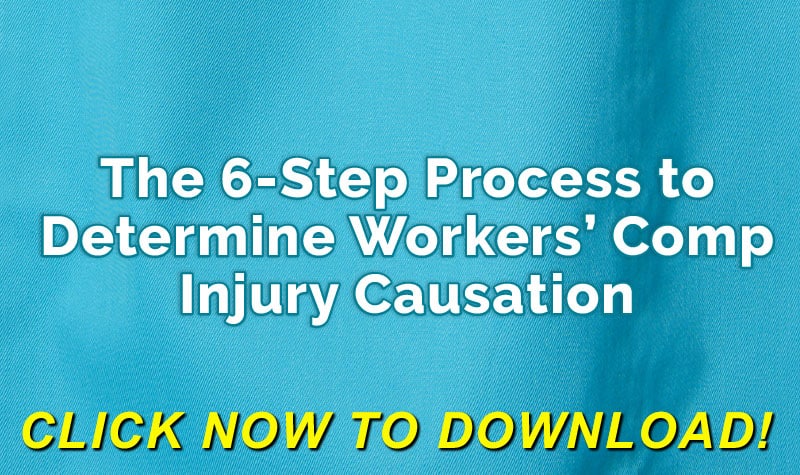
NCCI Report Highlights the Problem
The National Council on Compensation Insurance (NCCI) recently released a report regarding prescription drug costs in workers’ compensation case. The report sets forth the following encouraging conclusions:
Click Link to Access Free PDF Download
“The 6-Step Process To Determine Workers’ Comp Injury Causation”
- Physician dispensing and use of more expensive brand name prescription medications are declining;
- While the prescription drug share of medical costs in workers’ compensation cases is at 13.7%, this amount declined by 2% in 2015, and 4% in 2016; and
- Main drivers in prescription drug usage include Lyrica, OxyContin, and Gabapentin, which account for more than 15% of prescription drug costs in 2016.
While some of these trends are positive, it should still be understood that more can be done by proactive claim handlers to control the costs of prescription drugs in workers’ compensation claims and run a more effective program.
Early Identification of Prescription Drug Abuse
All interested stakeholders should be on the look-out of for overuse and abuse of prescription drugs. Signs of misuse include the following:
- Identification of injured employee’s with risk factors that include past/present history of substance abuse, family history of substance abuse, and various psychological and/or psychiatric conditions;
- Injured employees that specifically request prescription medications by their name brand and refuse to accept generics; and
- Instances where someone regularly claims to lose their prescription drugs and is requesting a refill.
The existence of a pain management agreement is a common feature in most workers’ compensation laws in instances where an employee is using opioid-based drugs. This agreement should be strictly followed. There should also be a renewed effort on the part of everyone to direct an injured employee back to work, even if it is in a light-duty/sedentary capacity. Studies suggest strong return-to-work efforts significantly reduce the medical spend on any type of personal injury claim.
Multi-Faceted Approach to Reducing Prescription Medical Expenses
Proactive stakeholders in the workers’ compensation system can advocate for change to reduce the cost and human toll prescription drugs – mainly opioid-based – take on injured employees. This includes an effective three-pronged approach.
- Prevent new cases of opioid-based prescription medication abuse from occurring: This all starts with the use of a pain management agreement – and making sure it is strictly enforced. This zero-tolerance approach will ensure powerful pain medications are not misused or abused. Terms within the agreement should include exactly how the medications are to be used, random drug testing and consequences for false/positives, failed tests and missed testing, how replacement medications are to be dispensed and where all prescriptions are to be filled – avoiding physician dispensing protocols.
- Treat people who are addicted with compassion: No process is foolproof, and anyone can become addicted. It is important to treat individuals who suffer from this consequence are treated with respect and dignity. All reasonable and necessary forms of treatment should be made available; and
- Use drug utilization measures to better target prevention and treatment: This is one of the most effective tools available to members of the claim management team in combating the abuse and overuse of opioid-based prescription medications. Drug utilization review (DUR) is the process of reviewing all aspects of prescription drug usage – prescribing, dispensing, and use of medication. It examines the individual usage of someone against predetermined criteria based on evidence-based medicine to ensure an effective and efficient result. The recent NCCI report also credited the effective use of DUR in driving down the amount of money spent on prescription drugs in workers’ compensation claims.
Conclusions
There are many negative consequences of prescription drug abuse and misuse in workers’ compensation cases. Steps are being taken to hold these adverse effects in check and also reducing workers’ compensation program costs. This can be accomplished by implementing an effective approach that includes drug utilization review in your program.

Contact: mstack@reduceyourworkerscomp.com.
Workers’ Comp Roundup Blog: https://blog.reduceyourworkerscomp.com/
©2019 Amaxx LLC. All rights reserved under International Copyright Law.
Do not use this information without independent verification. All state laws vary. You should consult with your insurance broker, attorney, or qualified professional.






